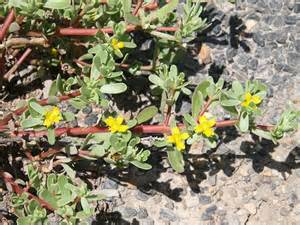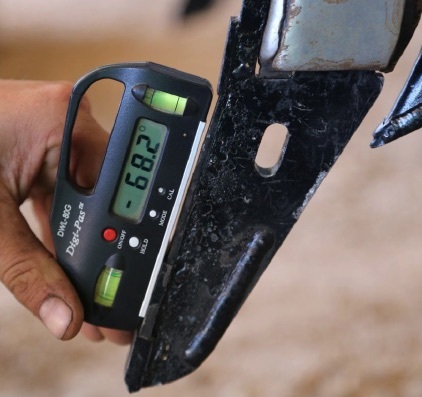
This article is bought to you by Air Seeder Consulting Services.
By Alastair Rayner - Rayner Ag
The potential for stock to consume poisonous plants is always much higher following droughts a break in the season or when moving into a new location. The capacity of weds to quickly respond to moisture often means they are the only green and growing vegetation in the first period after rain. And for hungry stock, the desire to nibble or chew these plants can be too great to ignore.
There are literally hundreds of poisonous plants growing across Australia. Some are endemic to locations, while others are much more common. In the last few weeks there have been a few issues emerging with weeds across many areas and its worth taking a moment to look at a few common species.
Pig Weed (Portulacaceae) is one of the more common weeds to emerge after rain, particularly on bare and disturbed areas. It’s a succulent lush feed that stock will readily eat if they have the opportunity. However-Pig Weed is often high in nitrates and oxalates, which in high concentrations can prove fatal for stock.

Pigweed is a common weed in disturb or bare areas
Caltrop (Tribulous) is another weed that is associated with nitrate poisoning. Again, this plant rapidly responds to rain fall and spreads out across disturbed and bare soil. The Yellow Vine Caltrop (Tribulus micrococcus) is an Australian species confined very much to NSW and the north west areas in particular. Besides the risk of nitrate poisoning Caltrop is associated with staggers in sheep. Often this occurs when sheep have grazed paddocks that are dominated by caltrop over many months.
Caltrop is associated with nitrate and staggers in sheep
According to NSW DPI this can lead to a progressive and irreversible weakness in a sheep’s hind limbs. This gradually will progress to the forelimbs and eventually the weakness will prevent the animal from standing or accessing feed or water. The disease is only recorded in central NSW, and may take some moths to develop, so it’s one to consider if caltrop is dominating a pasture.
While this disease has been recorded in NSW among sheep flocks, it doesn’t appear to impact cattle.
Several other common weed species that pose risks for nitrate poisoning include Fat Hen; Variegated thistle and Blackberry.
Preventing Poisoning: The biggest risk is often associated with hungry stock accessing these weeds. This rapid consumption of the plant means the rumen microbes cannot quickly convert the high levels of nitrate to ammonia. Animals that are in week or low body condition are also less effective in converting nitrates and are more susceptible to poisoning.
#FarmTender2020 - Focus on Farming Systems - June 5th, Bendigo, Vic

Tickets available now - click here
The simplest message for producers is to avoid allowing hungry stock to access these weeds. This may mean fencing off areas that are dominated by these plants until other species have recovered. It also means continuing to maintain drought rations a little longer while pastures re grow. There is an added bonus with these rations. NSW DPI research highlights animals receiving carbohydrate-rich feeds can tolerate high nitrate and nitrite levels better than stock who are not fed. This is because energy from carbohydrates (grain) helps rumen microbes convert nitrite to ammonia.
Kikuyu Poisoning: While an uncommon issue, the last few years have seen a number of coastal and northern NSW producers lose cattle to Kikuyu poisoning. The reasons are not fully understood; however, some research suggests a fungus is associated with the plant and this may be a contributing factor.
Kikuyu poisoning damages the stomachs of cattle, resulting in a situation where fluid accumulates in the rumen, but can't be absorbed into the blood stream. When this occurs cattle physically can’t drink as their rumen is at capacity. Cattle may try to drink however they are physically unable to take in any water. This leads to dehydration and eventual death.
The challenge with this disease is it’s almost impossible to determine if kikuyu is a risk as affected kikuyu does not look any different to safe kikuyu. However, experience on the north coast of NSW suggests affected kikuyu is likely to be less palatable to cattle and they will avoid it if alternative feed is available.

Kikuyu poisoning on the NSW mid north coast (Image: The Land)
Most of the recorded deaths in recent years have occurred in paddocks when the cattle have no alternative feed available and the losses seem to end when cattle are removed from the affected pasture, or at least when they are offered alternative feed (silage or hay).
The risk seems greatest in periods of rapid growth following the season break. Again, having alternative feeds and not introducing hungry stock are major steps producers can take to prevent losses.
Lantana: Lantana poisoning is a major concern across many parts of Australia. Most poisoning comes when stock are introduced to areas where the plant is growing and start to eat it out of curiosity. Yong stock are the most susceptible. Cattle bred in areas where lantana is common have learnt to avoid the plants unless starving.
The risk from Lantana comes from triterpene acids, lantadene A (rehmannic acid), lantadene B. Research into lantana has shown a toxic dose for a 500 kg cow varies from about 5 to 20 kg of fresh leaf (one per cent or more of an animal's body weight), depending on the toxin content of the lantana eaten.

Young cattle and stock new to an area are most at risk from lantana poisoning
Lantana poisoning can result in photosensitisation (which is extreme sensitivity to sunlight); liver damage and jaundice. In extreme cases one feed of lantana can result in signs appearing within 24 hours and death may occur in 2 – 4 days. Although if untreated death may take a week to a fortnight.
Treatment needs to occur quickly if animals are to recover. Without raid veterinary treatment severely affected cattle almost invariably die within 10 days of eating the plant. However, cattle that are responded to quickly have a good chance of recovery.
The key message is to avoid grazing new stock or young stock in areas where lantana grows. No matter how aware cattle may be of lantana, hungry stock will always be at risk, so try and avoid grazing hungry stock in those paddocks.
“If you see something unusual, don’t hesitate, call your vet and get help!
Ultimately most weed poisonings are likely when stock are hungry and tempted to have a feed. As we come out of drought for the first few weeks the only green pants will be weeds. In those instances, try and restrict access and keep your rations in front of your stock. Most importantly if you see animals showing any unusual signs or symptoms, don’t wait, call your vet and get help!
Ad - Get your Seeder set up the right way. Contact Air Seeder Consulting Services and have your Seeder running right before you start - Ad 











Share Ag News Via